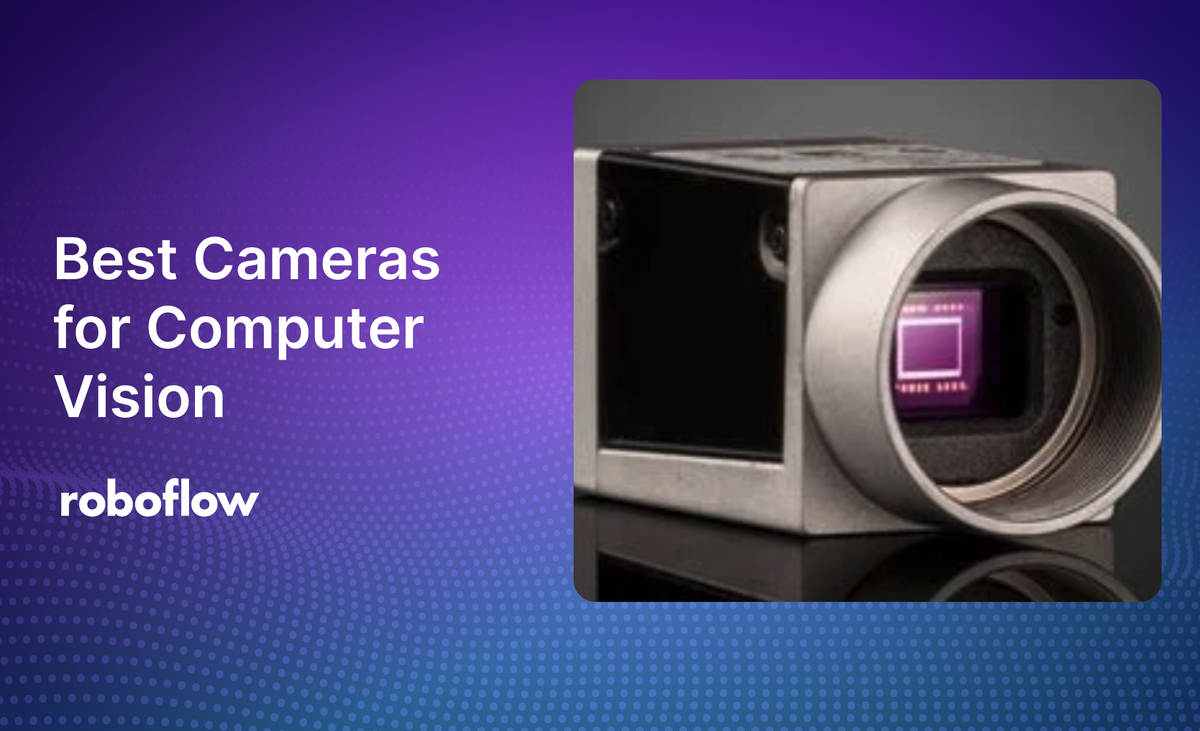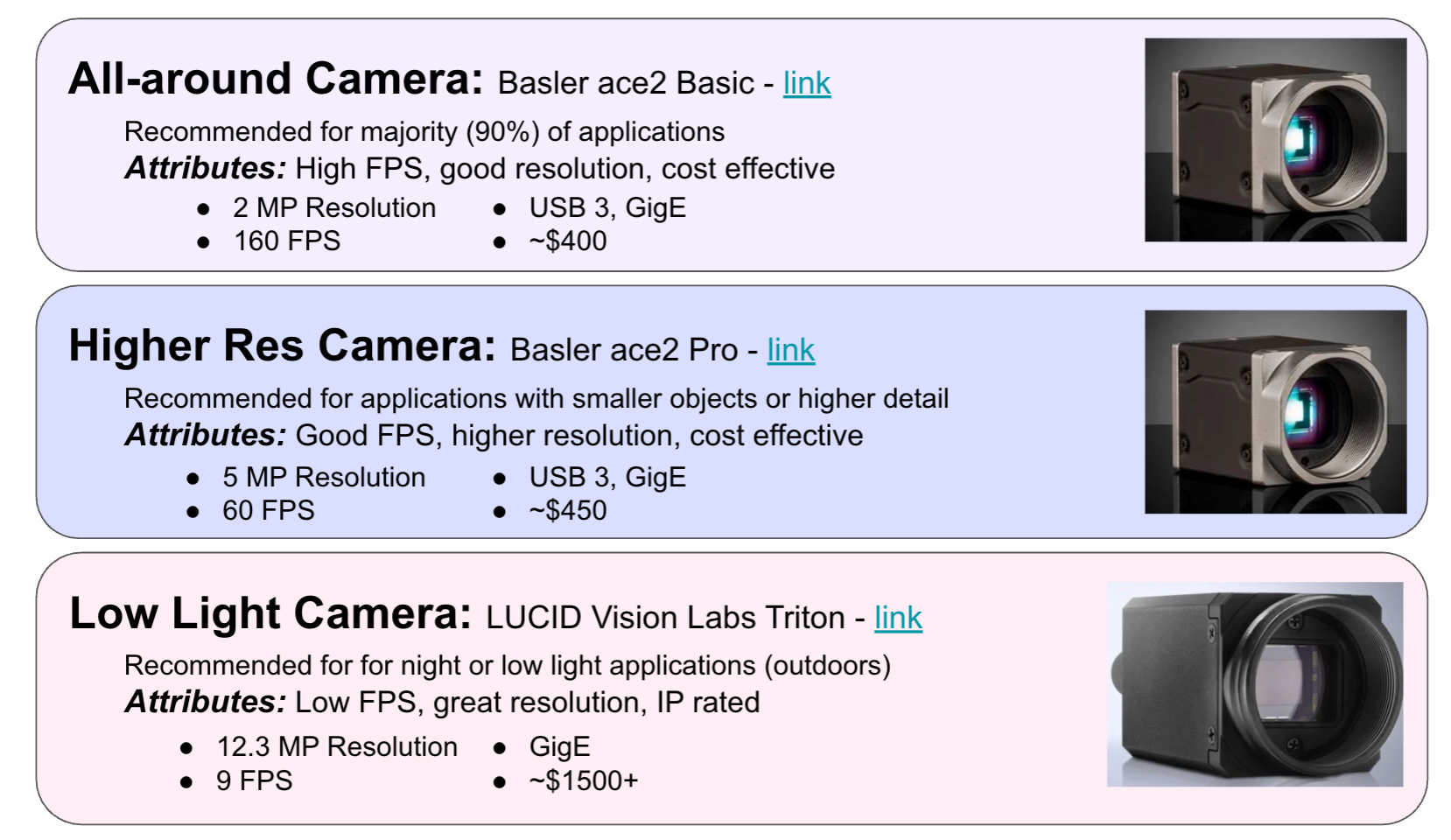
Selecting the right camera is foundational to the success of any computer vision project.
The appropriate camera can drastically enhance the performance of computer vision algorithms by providing high-quality images that are crucial for accurate analysis and decision-making. Conversely, the wrong camera can lead to poor system performance, regardless of the sophistication of the software algorithms.
In this article, we will start with our top three camera recommendations. We will then analyze key factors you should consider when making a choice about what camera to buy, from shutter types to interfaces through which you can interfact with a camera.
Our Camera Recommendations
Choosing the right camera for your computer vision application can be challenging, given the myriad of options available. To simplify this process, we’ve identified three standout cameras that cater to a wide range of scenarios, from general-purpose applications to specialized tasks requiring high resolution or low-light performance. Here’s a closer look at our top picks:

Best All-around Camera: Basler ace2 Basic
The Basler ace2 Basic is our top recommendation for the majority of computer vision applications, covering a vast majority of use cases. This camera strikes an excellent balance between performance and cost, making it ideal for a wide range of tasks.
• Attributes: High FPS, good resolution, cost-effective
• Resolution: 2 MP
• Frame Rate: 160 FPS
• Connectivity: USB 3, GigE
Whether you’re working on object detection, facial recognition, or motion tracking, the Basler ace2 Basic provides reliable performance without breaking the bank.
Best Higher Res Camera: Basler ace2 Pro
For applications that require higher detail and resolution, the Basler ace2 Pro is an excellent choice. This camera is perfect for tasks involving smaller objects or where higher image fidelity is necessary.
• Attributes: Good FPS, higher resolution, cost-effective
• Resolution: 5 MP
• Frame Rate: 60 FPS
• Connectivity: USB 3, GigE
The Basler ace2 Pro is ideal for detailed inspections, precision measurement, and other applications where capturing fine details is crucial.
Best Low Light Camera: LUCID Vision Labs Triton
When it comes to night or low-light applications, the LUCID Vision Labs Triton stands out. This camera excels in environments with poor lighting conditions, making it suitable for outdoor surveillance and other challenging scenarios.
• Attributes: Low FPS, great resolution, IP rated
• Resolution: 12.3 MP
• Frame Rate: 9 FPS
• Connectivity: GigE
With its high resolution and excellent low-light performance, the LUCID Vision Labs Triton ensures that you capture clear and detailed images even in the darkest conditions.
Understanding Project Requirements
Before diving into the technical specifications of cameras, it's crucial to first identify and understand the specific requirements of your computer vision application. Different tasks will demand different capabilities from a camera, and what works for one application may not be suitable for another.
First, no matter what application you are building, image quality is essential. High-quality images with low noise are crucial for accurate analysis, especially in low light conditions.
Second, cameras must be capable of performing under the lighting conditions prevalent in the application area, whether it’s indoor, outdoor, or variable lighting.
Third, consider the operational environment in which your project will be deployed. Consider if the camera needs to withstand harsh conditions such as extreme temperatures, moisture, or vibrations.
Fourth, consider the required processing time for your system. Are you deploying a model that will run on an assembly line or in another environment where video is processed in real time? If so, you will need a low-latency camera.
The camera should be capable of handling the data throughput necessary for real-time analysis, which involves both the camera’s interface and the processing unit’s capability to handle the incoming data stream.
If you are working in an environment where frames are captured less frequently – for example, a security monitoring system – you may not need to invest as much in a low-latency camera.
By thoroughly understanding these requirements, you can better evaluate which camera specifications are most critical for your computer vision application.
Key Camera Specifications
When selecting a camera for computer vision applications, certain technical specifications are crucial to consider. These specifications directly impact the performance of the camera in capturing images that are suitable for analysis by computer vision algorithms. Here’s a detailed look at the key camera specifications you need to evaluate:
Resolution
Higher resolution cameras capture more detail, which is vital for accurately identifying features in an image, especially in applications like precision measurement or defect detection.
Consideration: Determine the minimum resolution needed based on the smallest object feature you need to detect or the finest detail required for analysis.
Frame Rate
Frame rate, measured in frames per second (fps), is critical for applications involving motion, such as tracking moving objects or video analysis.
Consideration: Higher frame rates are necessary for capturing fast-moving objects without blur, ensuring smooth video playback and effective motion analysis.
Sensor Size
The size of the camera sensor affects how much light it can capture, impacting image quality, especially in low-light conditions.
Consideration: Larger sensors generally provide better image quality but can increase the cost and size of the camera.
Lens Compatibility
The choice of lens affects the field of view, depth of field, and potential for zoom, which are essential for framing your subject correctly.
Consideration: Ensure the camera supports interchangeable lenses if flexibility or specific lens characteristics are required for your application.
Specialized Camera Features for Computer Vision
For computer vision applications, beyond basic specifications like resolution and frame rate, there are specialized camera features that can significantly enhance performance in specific scenarios. Understanding these features can help tailor your camera selection to meet the unique demands of your computer vision project.
Low Light Performance
Many computer vision applications operate in less than ideal lighting conditions. Effective low light performance is crucial for maintaining image quality.
Cameras with larger sensors, better noise reduction algorithms, and advanced image processing capabilities tend to perform better in low light conditions.
Consideration: Evaluate the ISO range and noise levels at higher ISOs to ensure the camera can capture usable images in dim environments.
Dynamic Range
High dynamic range (HDR) is essential for scenes with high contrast, where both bright and dark areas are present.
HDR cameras can capture multiple exposures of a scene and combine them to enhance detail in both shadows and highlights.
Consideration: For applications like outdoor surveillance or vehicle navigation, where exposure to varying lighting conditions is common, HDR capability is beneficial.
Shutter Type
There are two shutter types: rolling and global.
Global shutters capture an entire image simultaneously, eliminating motion artifacts. Ideal for capturing fast-moving objects.
Rolling shutters capture am image in a sequence from top to bottom, which can lead to distortions in fast-moving scenes.
Consideration: Choose global shutter cameras for high-speed applications like traffic monitoring or automated inspection systems where motion blur can be a concern.
These specialized features can dramatically affect the performance of a computer vision system by enhancing the camera's ability to capture high-quality images under various conditions. When selecting a camera, consider these features in the context of your specific application needs to ensure optimal performance.
Connectivity and Integration
The ability of a camera to seamlessly integrate with existing systems and handle data efficiently is crucial for the success of computer vision applications. This section explores the various connectivity options and integration considerations that are essential when selecting a camera.
Interface Types
There are two common interface types for computer vision cameras: USB and GigE.
• USB: Common and easy to use, suitable for low to moderate speed requirements. USB cameras are plug-and-play, making them ideal for desktop applications and simple setups.
• GigE (Gigabit Ethernet): Offers high data rates and long cable lengths, making it suitable for industrial environments where cameras may be far from the processing unit.
Software Compatibility
Ensure the camera is supported by readily available drivers. This compatibility is crucial for facilitating development and integration into existing systems.
Check if the camera manufacturer provides a robust software development kit (SDK) or application programming interfaces (APIs) that allow for extensive customization and control over camera functions.
System Integration: Camera Size and Power
Consider the physical size and mounting options of the camera to ensure it fits within your setup, especially in constrained spaces or where specific mounting options are necessary.
In addition, check if the camera can be powered through the interface (like PoE - Power over Ethernet) or if it requires a separate power supply, which could affect the setup and maintenance complexity.
Questions to Guide Vision Camera Choice
When considering which camera to select for a computer vision project, asking the right questions can guide your decision-making process effectively. Here are some helpful questions to consider:
What is the primary application of the camera?
Understanding the specific use case, such as inspection, measurement, or identification, helps in selecting a camera with the appropriate capabilities and specifications.
What are the environmental conditions where the camera will be used? (Do I need to protect my camera?)
It's crucial to know if the camera will operate in harsh conditions such as extreme temperatures, moisture, or dusty environments. This affects the choice of camera housing and any additional protective measures.
What are the required resolution and field of view? (How far is the camera positioned and what size are the objects?)
The resolution necessary for the application determines the level of detail the camera needs to capture. Field of view requirements help determine the sensor size and resolution needed.
What is the required image acquisition speed? (How fast are the objects moving?)
Understanding the speed at which the camera needs to capture images (frames per second) is vital, especially for applications involving moving objects or high-speed processes.
What lighting conditions will the camera operate under?
Different sensors perform differently under various lighting conditions. Knowing whether the camera will be used in low light, bright light, or fluctuating conditions helps in choosing a sensor with suitable sensitivity and dynamic range.
What connectivity and integration capabilities are needed? (How far is the camera from the compute device?)
Asking about the required interfaces (e.g., USB, GigE, Camera Link) and compatibility with existing systems ensures the camera can be integrated smoothly into the customer’s current setup.
Conclusion
Choosing the right camera for your computer vision project is a critical decision that can significantly influence the success of your application. Throughout this blog, we have explored various aspects of camera technology—from understanding the specific requirements of your computer vision tasks and key camera specifications, to considering specialized features and practical considerations relevant to your industry and application environment.
By carefully evaluating each of these factors, you can make an informed decision that balances technical capabilities with practical constraints and budget considerations. Remember, the ideal camera not only meets today's needs but also accommodates future expansions and technological advancements.
We encourage you to use the outlined questions and recommendations as a starting point to carefully assess each option. With the right camera, your computer vision system will be better equipped to perform its intended tasks efficiently and accurately, thereby enhancing the overall value and effectiveness of your technological solutions.
Cite this Post
Use the following entry to cite this post in your research:
Reed Johnson. (Sep 19, 2024). Best Cameras for Computer Vision. Roboflow Blog: https://blog.roboflow.com/best-cameras-for-computer-vision/
